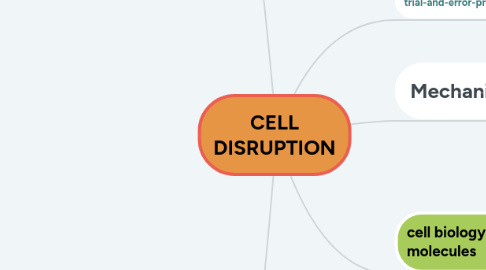
1. Uses mechanical forces to break the cell
1.1. liquid shear
1.1.1. ultrasound
1.1.1.1. sonicator
1.1.1.1.1. pulsed & high frequency sound wave
1.1.1.1.2. usually use with conjunction chemical method
1.1.1.1.3. multiple short burst
1.1.1.1.4. avdantage
1.1.1.1.5. diadvantage
1.1.2. mechanical agitation
1.1.2.1. mickle blending sonomec
1.1.3. pressure
1.1.3.1. chaikoff pressure
1.1.3.2. homoginiser
1.1.3.2.1. concept
1.1.3.2.2. common
1.1.3.2.3. celllular location
1.2. Solid shear
1.2.1. Bead Mill
1.2.1.1. Agitation of cell suspension + glass/steel beads
1.2.1.2. effectiveness
1.2.1.2.1. enzyme release
1.2.1.2.2. Large no. of small beads
1.2.1.2.3. Large sized cell are readily broken compared to bacteria
1.2.1.3. Beads
1.2.1.3.1. Type
1.2.1.3.2. size range
1.2.1.4. Heat prevention
1.2.1.4.1. cooling jacket (small vessel)
1.2.1.4.2. cooling through agitator shaft & impeller (large mill
1.2.2. Freeze Press
1.2.2.1. Frozen cell paste force under high pressure through narrow orifice
1.2.2.1.1. Hughess press
1.2.2.1.2. X-press
1.2.2.2. disruption being produced by
1.2.2.2.1. phase
1.2.2.2.2. change in volume
1.2.2.2.3. solid shear due to ice crystal
2. Different proteins react differently to different detergents, so finding the best detergent is usually a trial-and-error-procedure.
3. Mechanical
3.1. Disadvantages
3.1.1. Difficult to clarify
3.1.1.1. the cell debris reduce the size to small fragments
3.1.2. Expose harsh conditions to protein
3.1.2.1. denatured if expose to heat
3.1.3. Cells broken completely
4. Non Mechanical
4.1. Physical
4.1.1. Osmotic shock
4.1.1.1. change in the solute concentration around a cell
4.1.1.2. transfer the cell under high concentration of either salts, substrates or solutes to distilled water
4.1.1.3. Types of osmotic solution
4.1.1.3.1. ISOTONIC SOLUTION
4.1.1.3.2. HYPERTONIC SOLUTION
4.1.1.3.3. HYPOTONIC SOLUTION
4.2. Chemical
4.2.1. Organic Solvents
4.2.1.1. Act on membrane by:
4.2.1.1.1. By solubilizing protein
4.2.1.1.2. Denature protein
4.2.1.2. Examples of solvents used:
4.2.1.2.1. Toluene
4.2.1.2.2. Acetone
4.2.2. Acid/Alkali Treatment
4.2.2.1. used for?
4.2.2.1.1. plasmid DNA isolation
4.2.2.2. advantages
4.2.2.2.1. easiest method
4.2.2.2.2. least expensive
4.2.2.2.3. used for laboratory and industrial scale
4.2.2.2.4. the method is fast, reliable and relatively clean way to isolates DNA from cells.
4.2.2.3. solution used
4.2.2.3.1. sodium hydroxide (NaOH)
4.2.3. Detergent
4.2.3.1. alternative to physical disruption cell membrane
4.2.3.1.1. solubilizing the phospholipid disrupting
4.2.3.2. categories
4.2.3.2.1. anionic
4.2.3.2.2. cationic
4.2.3.2.3. non ionic
4.2.3.3. take note!
4.2.3.3.1. large number of proteins denature or precipitate in presence of detergents
4.2.3.3.2. the detergent needs to be subsequently removed from the product and this usually involves an additional purification/polishing step in the process
4.3. Enzymatic
4.3.1. Enzymatic Lysis
4.3.1.1. Less popular for industrial purposes
4.3.1.2. Lysozyme available on commercial scale
4.3.1.2.1. From hen egg white
4.3.1.3. Lysozyme used to
4.3.1.3.1. Digest polysaccharide
4.3.1.3.2. Lyse Gram +ve bacteria
4.3.1.4. Main drawbacks (large scale)
4.3.1.4.1. Cost
4.3.1.4.2. Necessity to remove enzyme from product
4.3.1.5. Lysozyme found in human secretions
4.3.1.5.1. Tear
4.3.1.5.2. Milk
4.3.1.5.3. Mucus
4.3.1.5.4. Saliva
4.3.1.6. Other enzymes that can be used?
4.3.1.6.1. Lysostaphin
4.3.1.6.2. Zymolase
4.3.1.6.3. Mutanolysin
4.3.1.6.4. Mannase
4.3.1.6.5. Glucanase

